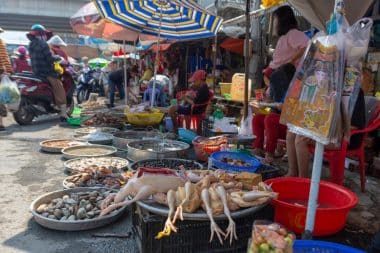Breathtaking nature, beautiful beaches and paradisiacal sights: this is Phu Quoc. Vietnam’s largest island in the middle of the Gulf of Thailand is still a real insider tip for many holidaymakers from all over the world. More and more tourists are now discovering the advantages of this paradisiacal island for themselves, also due to the very good infrastructure. Phu Quoc has an international airport that is served daily by planes from all over the world. There are also several ports on the island. These can be approached by cruise ships as well as private boats.
Dreamlike beaches – a feeling like paradise
A large part of the tourists are drawn to the dream beaches of the island. With their white sand, crystal clear water and shady palm trees, they are among the most beautiful beaches in Southeast Asia. Here you feel like you are in the middle of paradise. The absolute number one of the beaches on the popular island is Bai Truong at the gates of the island’s capital Duong Dong. The beach, also known as “Long Beach” by Western tourists, stretches over 20 kilometers along the west coast. Beach holidaymakers get their money’s worth here, as do water sports enthusiasts. Especially on the northern section of the beach, thousands of tourists from all over the world cavort, especially in the European winter months.
In recent years, numerous large beach resorts with a comprehensive range of water sports have also been built here. Bai Truong is also famous outside the Vietnamese borders for its clean water, because no motorboats are allowed here. In the meantime, the southern section of the beach is also being developed more and more and discovered by tourists. If you like it quieter on the beach, the much smaller Bai Ong Lang in the south of the island’s capital is the right place for you. Due to the small sheltered bays, the beach is especially popular with couples. Sao Beach is also one of the most popular beaches on the island, with its white sand and gently sloping water into the sea. In addition to the numerous water sports such as jet skiing or parasailing, there are also numerous restaurants and hotels around the beach.
Duong Dong: The lively island capital

The capital of Phu Quoc is the city of Duong Dong. The city of 60,000 inhabitants is known and loved by tourists and locals as extremely lively. In the traditional Vietnamese small town, there is always a lively market hustle and bustle and Asian flair. Directly on the beach is the Dinh Cau temple, which you should definitely see when visiting the city. It is not only one of the most popular photo motifs on the island, but is also extremely worth seeing and experiencing. From the terrace of the temple you have a great overview of the beach and the fishing port. The port of Duong Dong is also a popular starting point for small and large island tours. Near the port is also the Duong Dong Market. The rest of the island also has some spectacular sights to offer. In the south of the island, for example, you should not miss the Hon Thom cable car. With a length of almost eight kilometres, it is one of the longest cable cars in the world and extends to the offshore island of Hon Thom. On the island there is a large water park, a beautiful sandy beach and several cozy cafes and restaurants.
Species-rich flora and fauna
The island of Phu Quoc is also characterized by its species-rich flora and fauna. Nature lovers get their money’s worth, especially in the north of the island in the Phu Quoc Nature Park. The national park, which covers more than 30,000 hectares, is one of the most beautiful national parks in Asia. Almost 500 different plant species can be found here. Off the coast there are also beautiful coral reefs and a wide variety of colors. The wildlife on the island also has almost 50 different and above all rare mammal species – including small-clawed otters, dwarf gloris and silver langurs. The coasts in the south are also home to more than 120 different species of fish. The island can be explored on your own or as part of a guided tour by a trained guide. Among other things, the island still has some mountains, grottos and caves.
Best time to visit Phu Qouc: November to March
The weather on the popular Vietnamese island is determined by the tropical climate with hot temperatures and high humidity. From November to March, temperatures are around 30 degrees Celsius. Precipitation is rarely to be expected during this time. May to October is the rainy season, during which continuous and extensive rainfall is to be expected


